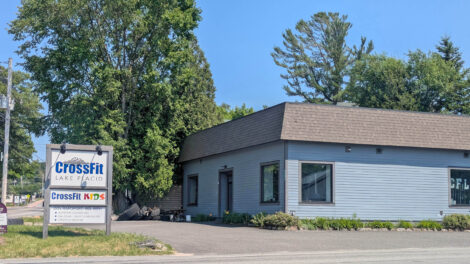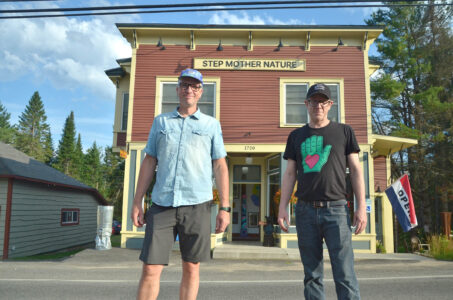Balancing Lake Ontario with the St. Lawrence

Water rises above the dock at Henchen Marina in Henderson on Tuesday as water levels continue to rise. (Provided photo — Sydney Schaefer, Watertown Daily Times)
Outflows from Lake Ontario continue to be adjusted to balance the impacts of high water levels between Lake Erie and the lower St. Lawrence River.
According to the International Lake Ontario-St. Lawrence River Board, several months of wet weather followed by especially heavy rains and snowmelt over the past few weeks caused record-breaking Ottawa River flows and resulted in severe flooding along both the Ottawa and lower St. Lawrence Rivers. Outflows from Lake Ontario were temporarily reduced, helping to mitigate — but not eliminate — the impacts in the lower St. Lawrence during the peak of this event. Lake Erie water levels have been above seasonal records since the end of April and exceeded historic record highs at the start of May. Record inflows from Lake Erie combined with the reduced outflows caused Lake Ontario levels to rise rapidly over the past several weeks.
Although Lake Ontario water levels remain below the record highs of 2017 as of Friday, the levels have reached the criterion H14 high level that applies this time of year, authorizing the International Lake Ontario-St. Lawrence River Board to deviate from regulation Plan 2014.
At this time, with high water impacts continuing both upstream and downstream, the board stated it has reached consensus to continue to adjust outflows according to the F-limit rules of Plan 2014. The F-limit balances high levels upstream on Lake Ontario and the upper St. Lawrence, with those downstream on Lake St. Louis and the lower St. Lawrence. St. Lawrence River levels at Lake St. Louis near Montreal will be maintained at 22.48 meters, or 73.74 feet, as Lake Ontario has now risen to 75.60 meters, or 248.03 feet. Lake Ontario outflows had been increasing rapidly in recent days, but heavy rains have caused Ottawa River flows to rise again, and temporary outflow reductions are expected to be required over the next few days. Lake Ontario outflows will be increased again as soon as conditions allow and as rapidly as possible.
Uncontrolled inflows from Lake Erie through the Niagara River and precipitation continue to be the main driver of water levels. The board reports it is constantly monitoring the situation and making use of every opportunity to adjust outflows, with the intent to balance high water levels in the interests of all stakeholders, and to regulate Lake Ontario outflows to provide all possible relief to shoreline property owners and communities both upstream and downstream of the Moses-Saunders Power Dam.
Between the U.S. Army of Corps of Engineers and the International Lake Ontario-St. Lawrence River Board, there is a possibility Lake Ontario could rise an additional 7 inches by June 10.
Local impacts to the Jefferson County shoreline include, but are not limited to, flooding at the Sackets Harbor boat launch, as well as throughout Henderson Harbor and Chaumont.
Sandbags are available for town of Hounsfield and village of Sackets Harbor residents at the wastewater treatment facility, 249 Hill St. For Henderson, a limited supply of sandbags is available for Henderson property owners at the town highway garage, 12105 Town Barn Road. As indicated on the town’s website: “homes in danger of flooding should take precedence over lawns, seawalls and boathouses.” In Chaumont, sandbags are available through the town of Lyme Highway Department, State Route 12E, next to the new salt barn. The town asks that “you (town residents) only take what you need and remember there will be others who will need them as well.”
Proper sandbagging/installation techniques are available on the State Homeland Security and Emergency Services website.
In Oswego County, a local state of emergency has been declared along the Lake Ontario shoreline from the town of Oswego to the town of Sandy Creek. Oswego County Legislature Chairman James Weatherup made the declaration at noon Tuesday due to flooding conditions on Lake Ontario.
Weatherup also issued a local emergency order for a “no wake zone” for boats 1,000 feet from the Lake Ontario shoreline and tributaries, including the Oswego Harbor, the Port of Oswego, Mexico Point, Port Ontario, South Sandy Pond and North Sandy Pond. All motorized boats within 1,000 feet of the shoreline and within these waterways must operate at an idle speed, creating no wake. The order is due to high water levels and floating debris that can cause hazardous conditions for boaters and others.
Weatherup said flooding conditions are anticipated and the state of emergency allows the county and local agencies “to take whatever steps necessary to protect life and property, public infrastructure, and provide such emergency assistance deemed necessary.” The emergency declaration and “no wake zone” order will remain in effect until further notice.
In addition to the protection of homes and property from rising water levels alone, groups like the Thousand Islands Association (TIA) are also concerned with damage from boaters.
“TIA has made 500 “CAUTION SLOW DOWN” signs to remind boaters that we are responsible for our wakes. Working in coordination with TIA President Allison Burchell-Robinson and New York Safe Boating Association President John McCullough, Save The River will have these signs available by May 20 on a first come-first served basis,” stated Save the River Executive Director, John Peach, in an email. “We encourage you to watch your boat wake and be mindful of the damage it can cause to waterfront property. For those of us fortunate to be on the River, now is a great time to offer assistance to neighbors who may not be aware of how high the water levels have risen.”
——
Oswego News staff contributed to this report.




